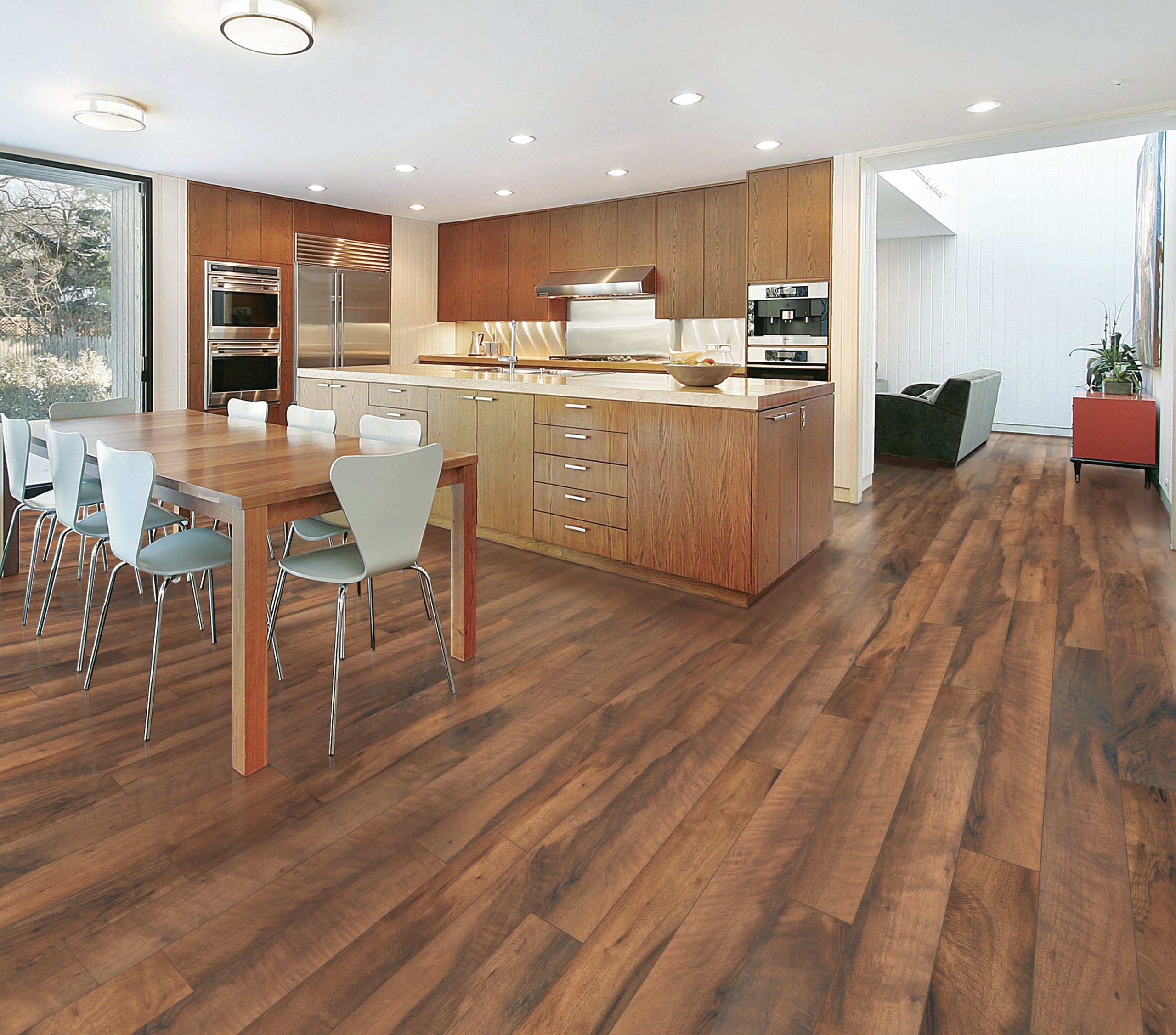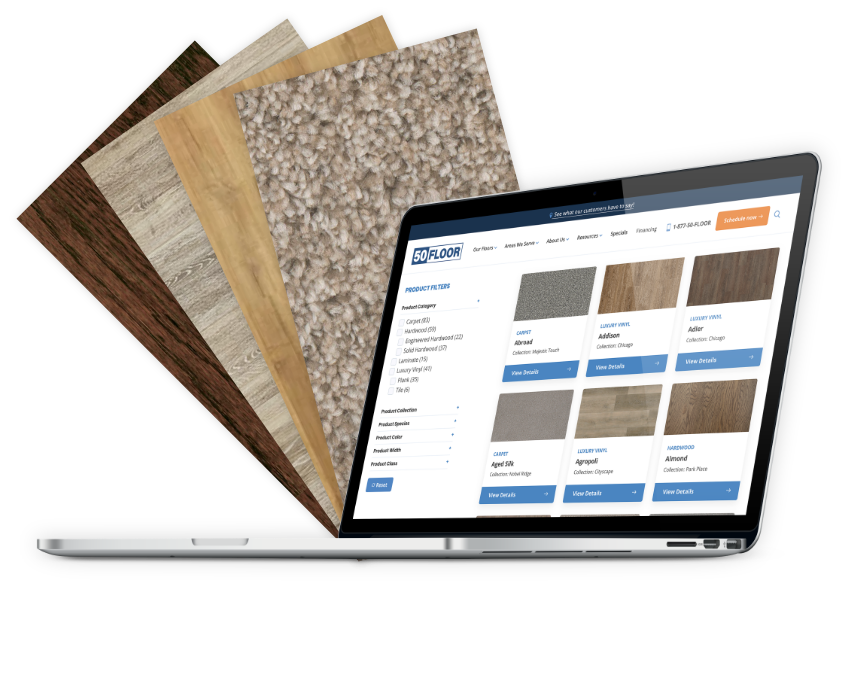Laminate flooring, a popular choice for many homes and businesses. The flooring is known to have durable layers and a backing layer for moisture resistance. This structure makes laminate flooring both versatile and hard-wearing.
Green laminate flooring takes this concept further by focusing on sustainability and environmental impact.
It incorporates eco-friendly materials and practices in its production process to minimize harm to the environment. This type of flooring is designed for those who prioritize ecological balance without compromising on quality or aesthetics.
We’ll dive into how these products are made, spotlighting companies that lead in green manufacturing practices.
You’ll also discover how selecting green laminate flooring can align with your preferences for a healthier planet.


Types of Green Laminate Flooring
By Material Content
Green laminate flooring stands out due to its eco-friendly materials. One key aspect is the use of recycled wood content. This approach not only reduces waste but also lessens the demand for new timber, contributing to forest conservation.
Another important factor is the selection of formaldehyde-free resins. These resins ensure that your flooring doesn’t release harmful volatile organic compounds (VOCs) into your home, safeguarding your indoor air quality.
By Manufacturing Process
The production methods behind green laminate flooring also play a role in its environmental footprint.
Manufacturers who adopt low-energy production techniques significantly reduce the carbon emissions associated with creating laminate flooring. They utilize renewable energy sources or efficient machinery to achieve this goal.
Sustainable forestry practices are equally vital. They ensure that the wood used in laminate floors comes from forests managed with long-term ecological health in mind. This means not only planting more trees than are harvested but also protecting biodiversity and local waterways.
By Certifications
When you’re selecting green laminate flooring, looking for specific certifications can guide you toward the most environmentally responsible options.
The NALFA certification is a mark of quality and sustainability within North America. It indicates that a product meets the standards for durability, health, and environmental impact.
Similarly, CARB certification focuses on reducing airborne toxins, including formaldehyde emissions from composite wood products. Choosing CARB-certified laminate flooring ensures that you’re bringing a safer, greener product into your home.




Benefits of Green Laminate Flooring
Reduces Waste
Choosing green laminate flooring not only benefits the environment but also enhances your living space. This sustainable option reduces waste, consumes less energy, and conserves natural resources.
Unlike traditional flooring options that may end up in landfills at the end of their life cycle, green laminate flooring often incorporates recycled materials. This approach lessens the demand for virgin resources, contributing to a healthier planet. Lower energy consumption during production means a smaller carbon footprint.
Improves Air Quality
But the advantages don’t stop there. You’ll find that green laminate flooring significantly improves your home’s indoor air quality by minimizing the presence of allergens. Plus, its performance features, like durability and scratch resistance, make it an excellent choice for busy households.
From a health perspective, you’ll appreciate how green laminate flooring can lead to improved indoor air quality. These products are designed to emit lower levels of volatile organic compounds (VOCs), which are harmful chemicals that can off-gas into your home. By choosing green laminate options, you contribute to a safer indoor environment free from these pollutants.
Summary
- Environmental Benefits:
- Reduced waste through recycling
- Lower energy consumption in production
- Conservation of natural resources
- Health Benefits:
- Improved indoor air quality with fewer VOCs
- Reduced allergens for healthier living spaces
- Performance Benefits:
- Durability and scratch resistance for longevity
- Ease of maintenance for hassle-free upkeep
GET INSPIRED
Flooring to MATCH YOUR STYLE
Considerations for Green Laminate Flooring
Cost
Generally, green laminate floors can be more costly than traditional options. This is due to the sustainable practices and materials used in their production. While this might seem like a downside at first, consider the long-term benefits and savings on energy and maintenance costs.
Availability
The availability of green laminate flooring can also pose a challenge. Compared to conventional laminate floors, eco-friendly options are less common on the market. This scarcity means you’ll need to do more research and possibly reach out to specialized suppliers. Yet, this effort pays off by ensuring your home improvement project aligns with environmental values.
Performance
Performance variations between products are another key factor. Not all green laminate floors offer the same level of water or scratch resistance.
Some might excel in durability, while others prioritize non-toxic materials for better indoor air quality. It’s essential to weigh these performance characteristics against your specific needs.
For families with pets or high-traffic areas, choosing a floor with superior scratch resistance might be preferable.
Despite these considerations, transitioning to green laminate flooring is a step towards a more sustainable lifestyle. By selecting these floors, you contribute to reducing harmful emissions and promoting healthier living environments.
Remember, each product comes with its own unique set of features and certifications that attest to its environmental friendliness.
















